E-waste Statistics By Generations, Top Producing Countries and Fact (2025)

Updated · Oct 30, 2025

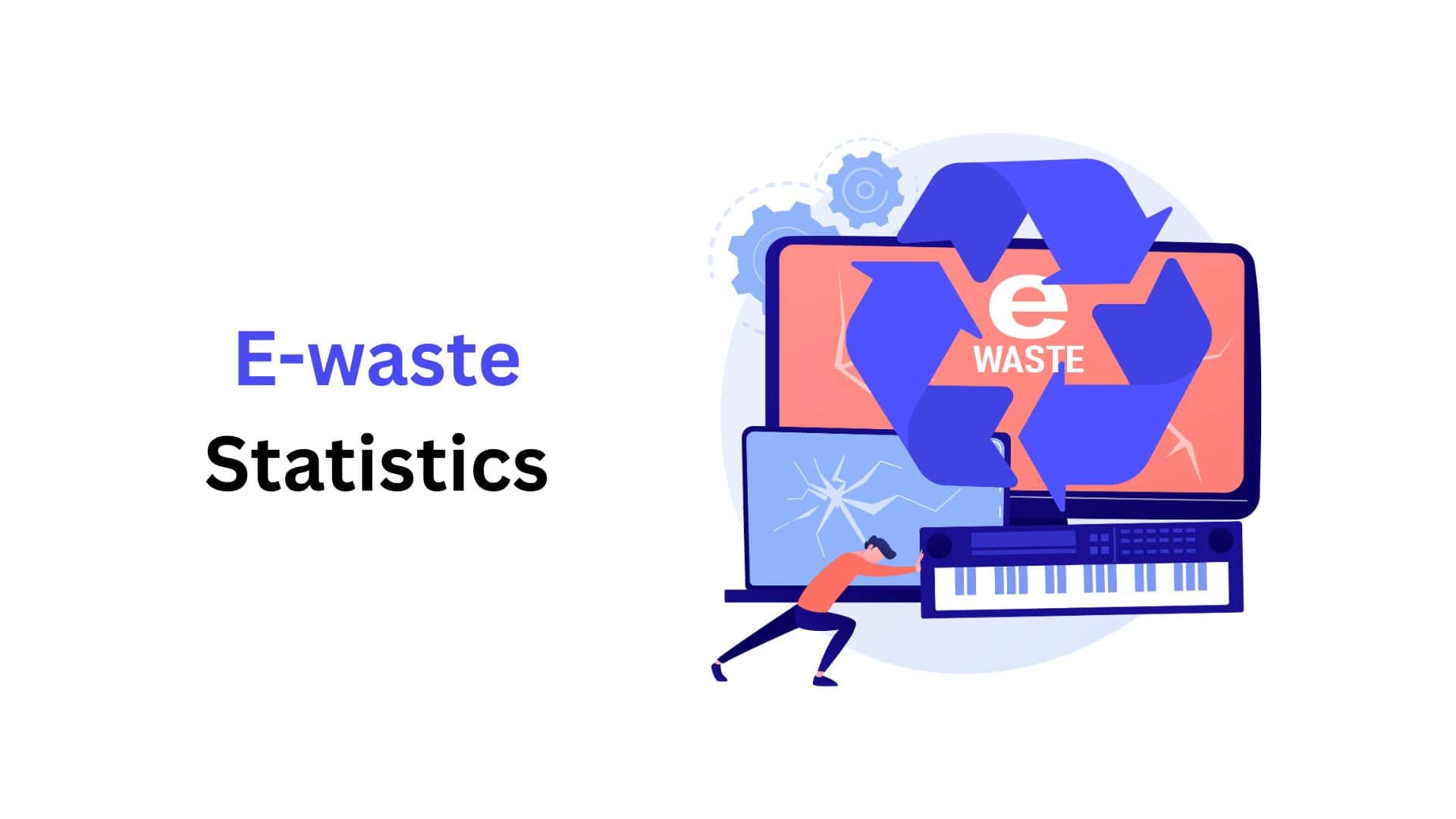
WHAT WE HAVE ON THIS PAGE
Introduction
E-waste Statistics: In 2025, electronic waste (e-waste) generation has made it one of the fastest-growing and most complex waste streams globally. With constant new advancements, millions of tonnes of e-waste, starting from defunct smartphones and computers to household appliances, are thrown away every year.
This E-waste poses severe environmental and health threats to the surrounding environment and even to the people who are around the junkyard due to the presence of toxic substances like lead, mercury, and cadmium.
However, it also represents an unavoidable opportunity, functioning as a veritable “urban mine” for the recovery of critical raw materials. Governments, private industries, and consumers are increasingly aware that some conservative measures are urgently needed to tackle the mountain-like challenges of e-waste management and to capture the enormous economic value within these non-usable devices.
So, in this article, we’ll have a walk around and an in-depth analysis of e-waste statistics to let you know about the growing market and how you can make use of it. Let’s get started.
Editor’s Choice
- The world produced a record 62 million tonnes (Mt) of e-waste in 2022, a figure that is up by 82% from the 34 Mt generated back in 2010.
- This 2022 volume of e-waste is roughly equivalent to the weight of 55 million 40-tonne trucks.
- The annual generation of e-waste is currently rising 5x faster than the world’s documented capacity for e-waste
- The raw materials embedded within the e-waste generated in 2022 were valued at approximately US$62 billion.
- The documented global collection and recycling rate for e-waste stood at just 3% in 2022, which means nearly 48 million tonnes of material were not formally accounted for.
- Experts project that the documented global collection and recycling rate will drop even further to 20% by 2030.
- Only 1% of the global demand for essential rare earth elements, which are crucial for modern technologies like renewable energy systems.
- In the United States, roughly 151 million mobile phones are tossed out annually, and recycling just one million of these phones can recover over 35,000 pounds of copper and 75 pounds of gold.
- Manufacturing a single computer and its screen requires enormous resources, including at least 240 kg of fossil fuels, 22 kg of chemicals, and 1.5 tonnes of water.
Global E-waste Generation Analysis
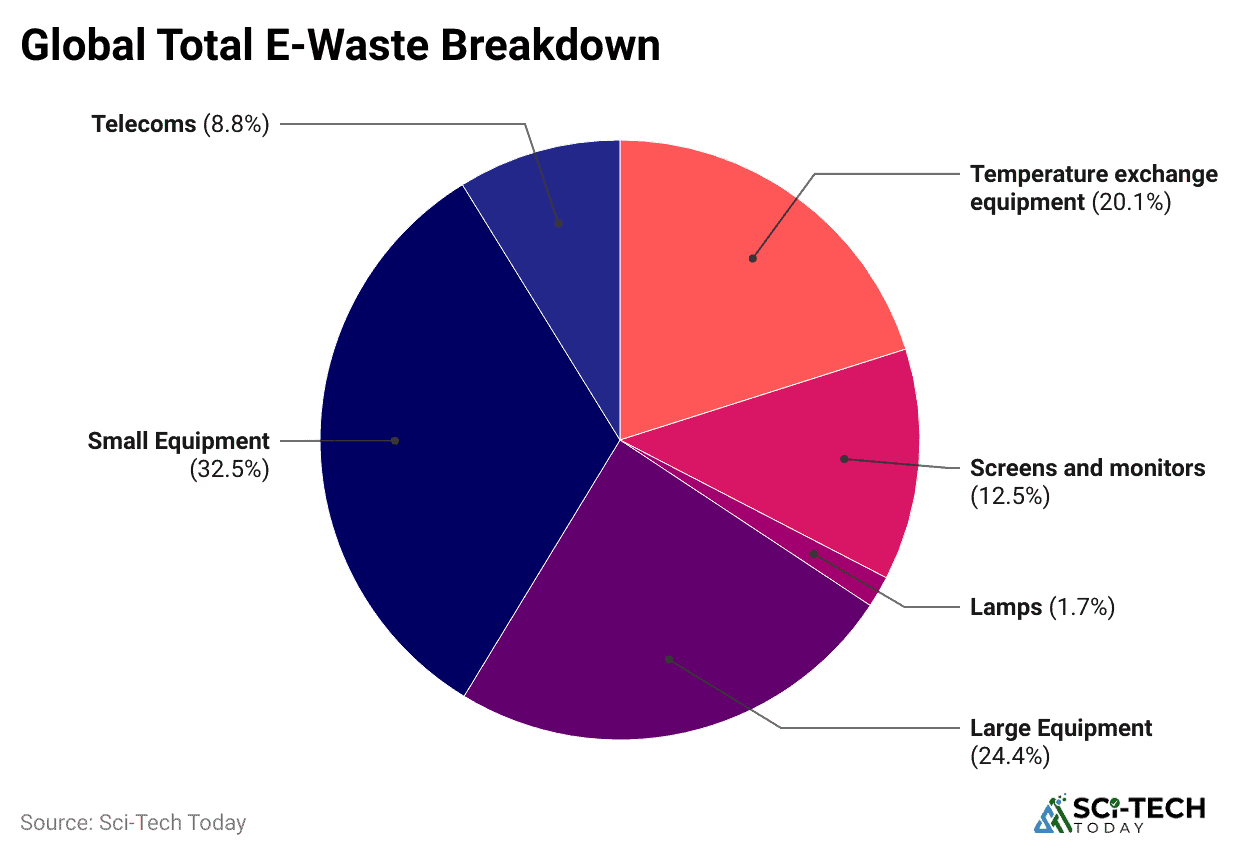
- The total mass of global e-waste generated has seen a dramatic increase, rising from 44.4 million tonnes (Mt) in 2014 to a record-breaking 62 Mt in 2022.
- This volume of e-waste is increasing at an annual rate of 2.6 million tonnes, showing a continuous and steep upward trajectory that far surpasses attempts at containment.
- Projections suggest that by 2030, the global annual production of e-waste will soar to 82 Mt, a massive 33% increase over the 2022 figure.
- In the most dire “business-as-usual” scenarios, some long-range forecasts even suggest that the total annual amount of e-waste could more than double by 2050, potentially reaching around 111 million tonnes.
- The average citizen is now generating a substantial amount of e-waste, with the global per capita figure standing at 7.8 kg per person in 2022.
- While e-waste only constitutes about 3.1% of the estimated 2 billion tonnes of total municipal solid waste generated annually.
| Year | Global E-waste Generated (Million Tonnes) | Change from 2014 (%) |
| 2014 | 44.4 |
N/A |
|
2018 |
51.8 | 16.7% |
| 2020 | 55.5 |
25.0% |
|
2022 |
62.0 | 39.6% |
| 2030 (Projected) | 82.0 |
84.7% |
Economic Value and Material Composition
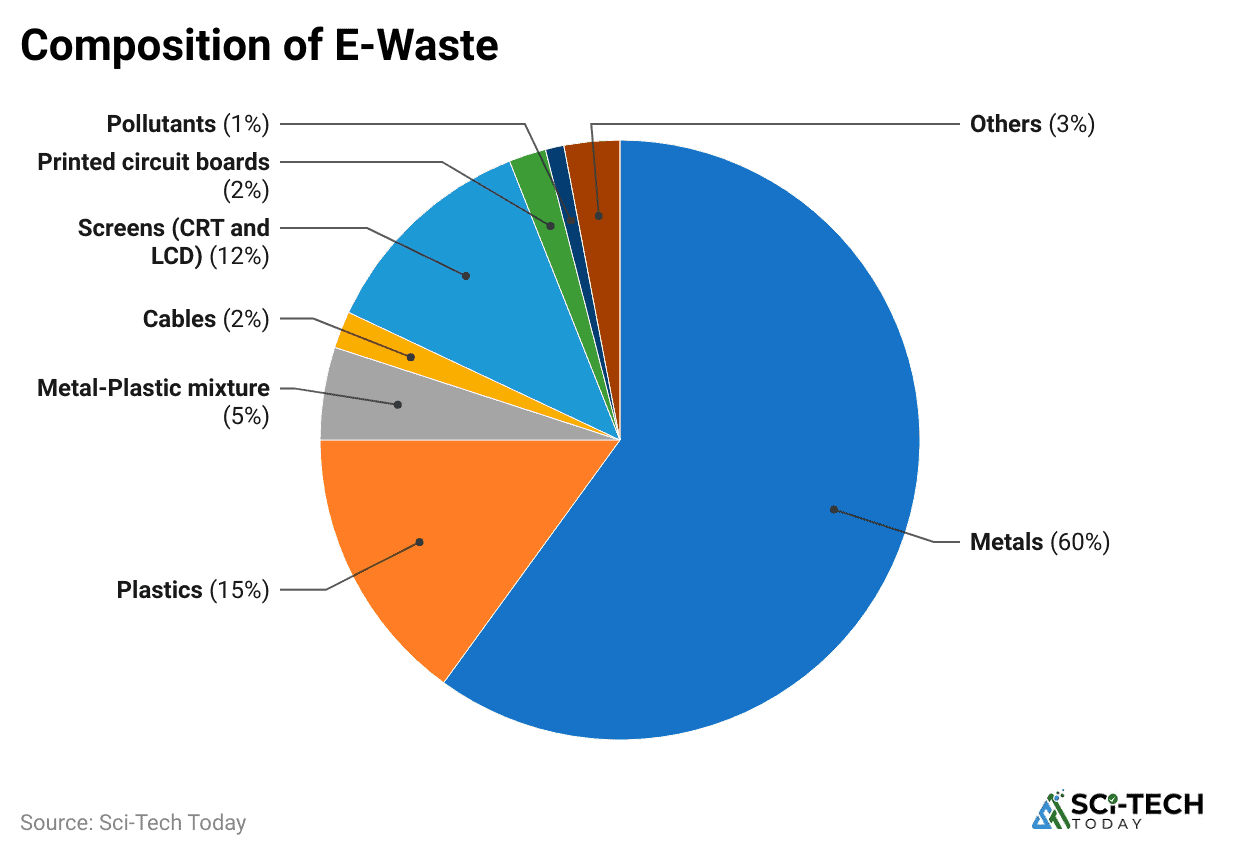
- The total monetary value of the raw materials embedded within the 62 Mt of e-waste generated in 2022 was conservatively estimated at US$91 billion before processing costs.
- Out of this massive value, only approximately US$19 billion worth of materials were recovered through documented and environmentally sound recycling efforts.
- Precious metals alone in the 2022 e-waste stream included an estimated US$15 billion in gold, US$19 billion in copper, and significant quantities of silver, palladium, and platinum.
- The vast material composition of e-waste includes an estimated 31 million tonnes of metals, 17 million tonnes of plastics, and 14 million tonnes of other materials like glass and composites, all ripe for recovery.
- Focusing solely on gold, some data suggests that one tonne of circuit board scrap can contain 40 to 800 times more gold than a tonne of primary gold ore.
- 99% of rare earth elements (REEs) used in electronics are not currently recycled, which is a major concern given their importance and concentrated supply chain dependence.
- Recovering materials from e-waste also translates directly into significant environmental savings, as the documented recycling in 2022 is estimated to have avoided the need for over 900 million tonnes of primary ore removal through mining.
| Material Embedded in E-waste (2022 Estimates) | Estimated Mass (Million Tonnes) | Estimated Value (US$ Billion) |
| Metals (Ferrous & Non-ferrous, Precious) | 31 | 91 (Total Material Value) |
| Plastics | 17 | Not readily quantifiable in this context |
| Other Materials (Glass, Minerals) | 14 | Not readily quantifiable in this context |
| Gold (within Metals) | Minor Fraction | 15 |
| Copper (within Metals) | Minor Fraction | 19 |
E-waste by Equipment Type
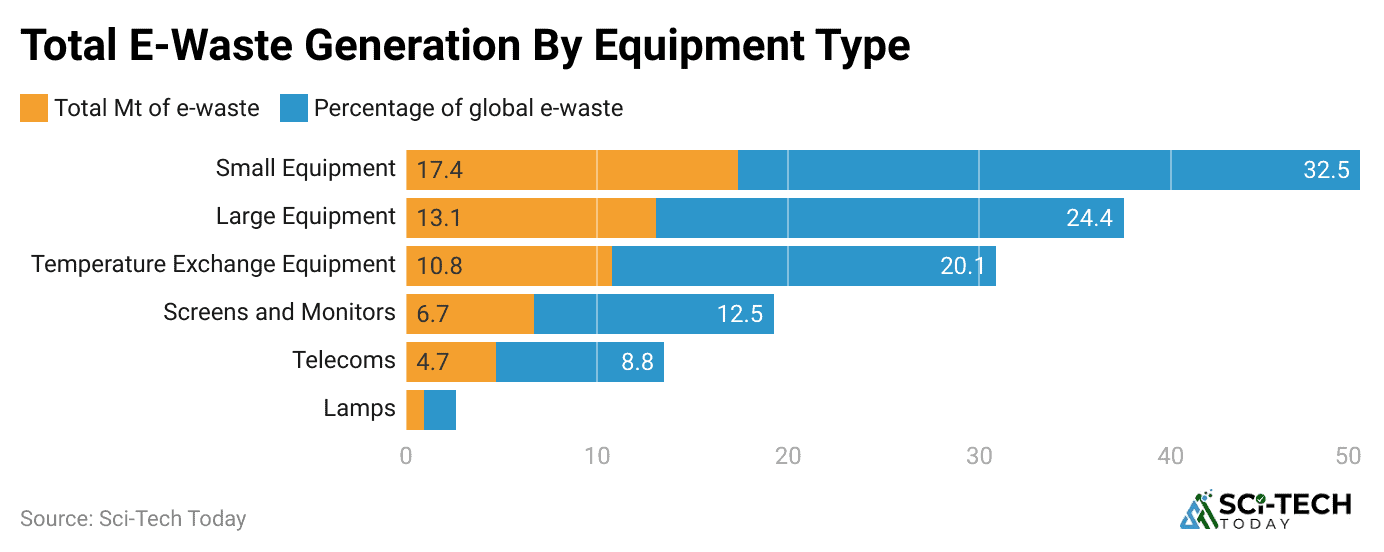
- Small equipment, a category including microwaves, vacuum cleaners, toys, and e-cigarettes, accounted for the largest share of e-waste by mass, contributing 20.4 million tonnes (33% of the total) in 2022.
- The collection rate for this massive category of small equipment is alarmingly low, with only about 12% of this e-waste being formally documented as collected and recycled.
- Large equipment, such as washing machines, large printers, and photovoltaic (solar) panels, was the second largest category, contributing 13.1 million tonnes (21.1%) to the global pile in 2022.
- Temperature exchange equipment, like refrigerators and air conditioners, made up a significant portion, generating 10.8 million tonnes (17.4%) and contributing to global warming through the release of potent refrigerants.
- Small IT and telecommunication equipment, which includes high-value items like mobile phones, laptops, and routers, contributed approximately 4.6 million tonnes and saw a documented recycling rate of only 22%.
- The volume of retired photovoltaic panels is a growing concern, projected to reach 2.4 million tonnes by 2030, a fourfold increase from the 600,000 tonnes generated in 2022.
- The smallest documented fraction came from lamps (light sources), which contributed 0.9 million tonnes (1.5%) of the total global e-waste in the measurement year.
| E-waste Category (2022) | Mass Generated (Million Tonnes) | Percentage of Total E-waste | Documented Recycling Rate |
| Small Equipment (Toys, Microwaves) | 20.4 | 33.0% | 12% |
| Large Equipment (Appliances) | 13.1 | 21.1% | Higher than average (Due to bulk) |
| Temperature Exchange (AC, Fridges) | 10.8 | 17.4% | Highest of all categories |
| Small IT & Telecom (Phones, Laptops) | 4.6 | 7.4% | 22% |
| Screens & Monitors | 6.7 | 10.8% | Higher than average |
The E-waste Management Market
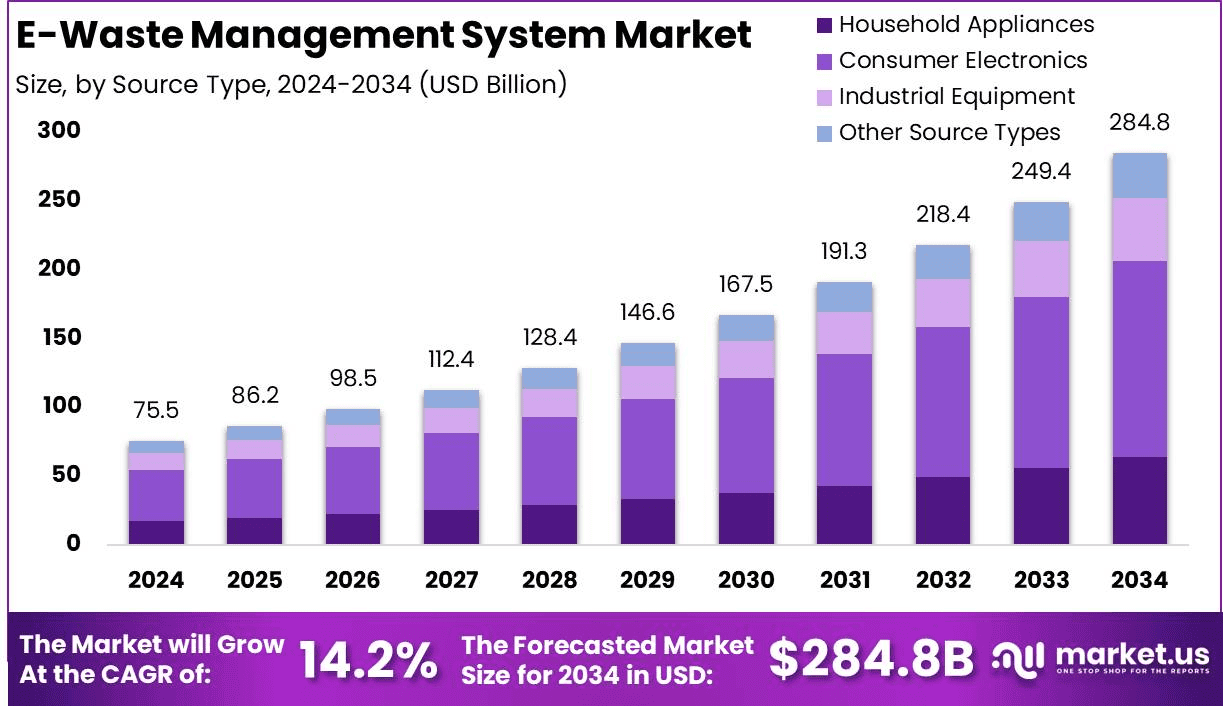
According to Market.us, the sector dedicated to the safe collection, processing, and recovery of e-waste is a rapidly expanding global market, driven by both environmental mandates and the rising cost of virgin raw materials.
- The global E-waste Management Systems market was valued at over $49 billion in 2021 and is projected to reach a valuation of over $111 billion by 2027.
- In the market for E-waste Management, the recovery of Metals consistently leads the material division, making up more than 65.8% of the total market share due to the high concentration and value of materials like aluminum, copper, and gold.
- Consumer Electronics, including smartphones, laptops, and peripherals, is the dominant source of e-waste feeding the management market, commanding over 49.9% of the market share.
- Regionally, the Asia Pacific area holds the largest market share in E-waste Management, accounting for over 48.1% of the total market value.
- The disposal application segment of the E-waste Management market, which includes environmentally sound final disposal of non-recoverable materials, took more than 76.0% of the total market share.
- The economic opportunity in countries like India is immense; one study suggests the country’s e-waste management market could reach a valuation of US$5,198.52 million by 2032.
| Market Segment | Leading Market Share (Approximate) |
| Material (Recovery Focus) | Metals (65.8%) |
| Source (Equipment Type) | Consumer Electronics (49.9%) |
| Application (Process Type) | Disposal (76.0%) |
| Region (Market Size) | Asia Pacific (48.1%) |
| Market Value Projection (By 2027) | $111 billion |
Regional Disparities in E-waste Management
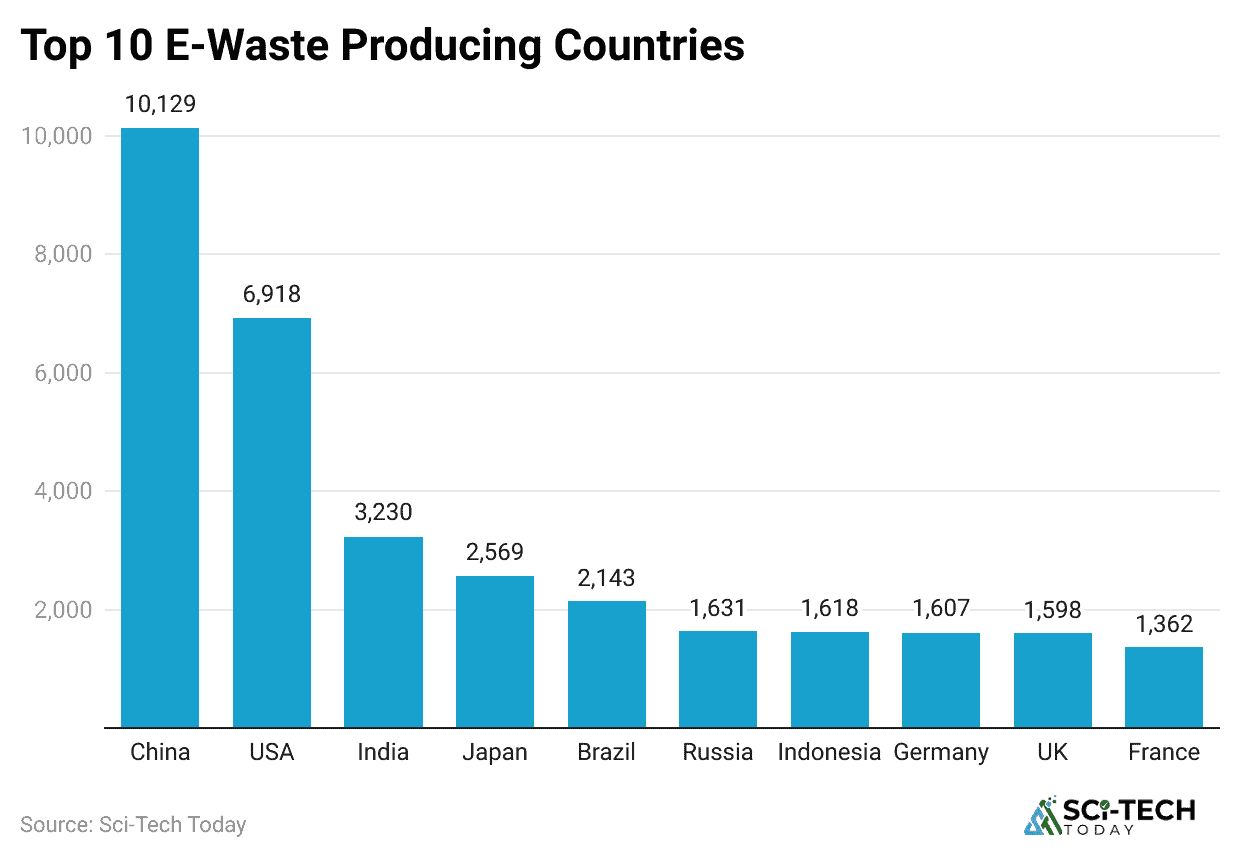
- Europe holds the top spot for per capita e-waste generation globally, producing 17.6 kg per person in 2022, slightly ahead of Oceania at 16.1 kg per person.
- Despite being the highest per capita generator, Europe also boasts the highest documented collection and recycling rate globally, reaching 42.8% in 2022 due to robust legislation and infrastructure.
- Asia is the largest generator of e-waste by total mass, producing approximately 30 million tonnes (nearly 50% of the global total) in 2022 due to its large population and rapid economic expansion.
- The Americas generated a total of 14.1 kg per person of e-waste in 2022, but their documented collection and recycling rate lagged significantly behind Europe, hovering around 30%.
- In stark contrast, African countries formally recycle less than 1% of their total e-waste.
- A substantial 18 million tonnes of e-waste in low- and lower-middle-income countries are managed primarily by the informal sector.
- Transboundary shipment of e-waste is a persistent issue, with an estimated 5.1 million tonnes (8.2% of the global total) crossing borders in 2022, of which 65% moved uncontrolled from high-income to lower-income nations.
| Region | Per Capita E-waste (kg/person, 2022) | Documented Recycling Rate (%, 2022) | Total E-waste (Million Tonnes, 2022) |
| Europe | 17.6 kg | 42.8% | Significant (Approx. 12.3 Mt) |
| Oceania | 16.1 kg | 41.7% | Relatively Low |
| The Americas | 14.1 kg | 30% (Approx.) | Significant (Approx. 13.1 Mt) |
| Asia | Lower than others | Low (Approx. 12%) | 30 (Approx. 50% of global total) |
| Africa | Lowest per capita | 1% (Formerly) | Relatively Low |
Hazardous Materials in E-waste
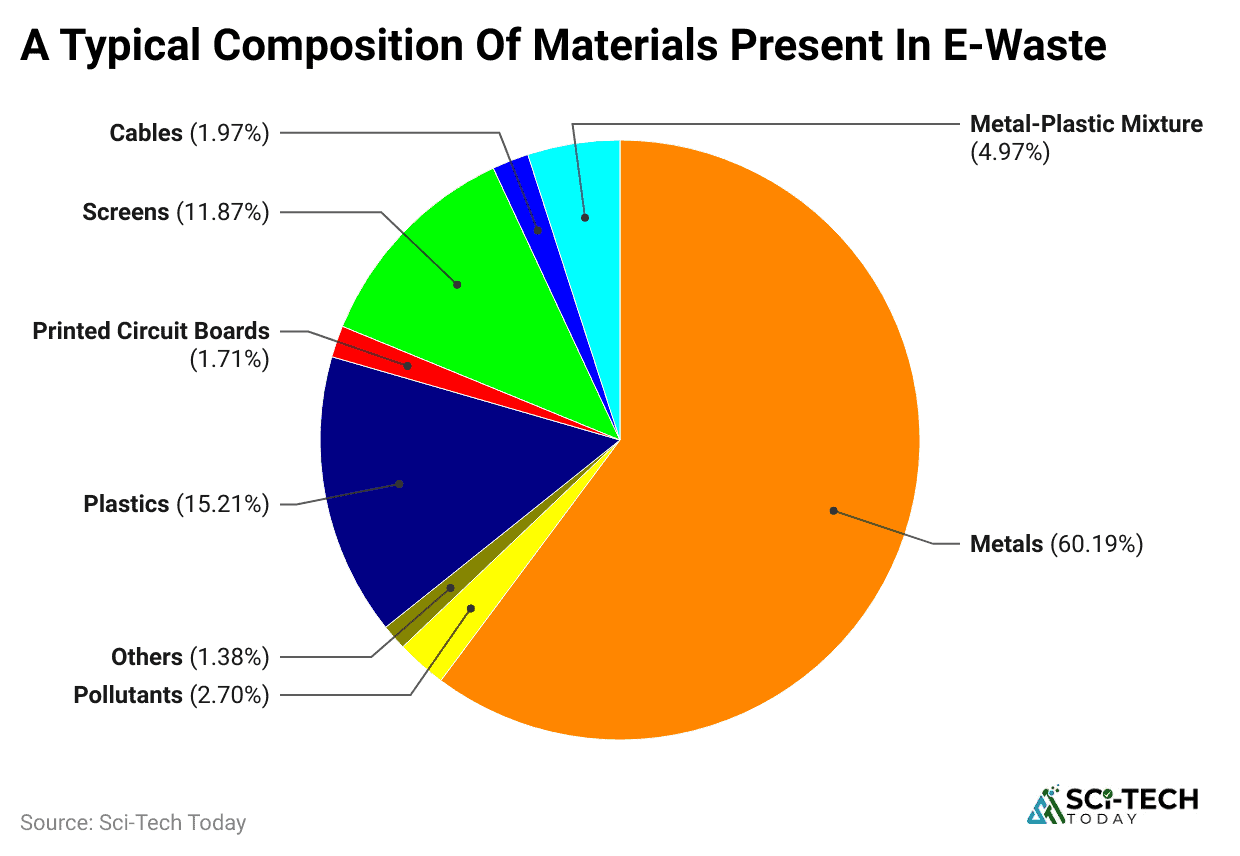
- E-waste contains numerous hazardous substances, including an estimated 45 tonnes of mercury and 79 kilotonnes of plastics with Brominated Flame Retardants (BFRs) in the undocumented waste flow in 2022.
- Mercury, often found in switches, sensors, and fluorescent lamps, is a potent neurotoxin that can cause chronic damage to the human brain and coordination system.
- Lead, historically used in CRT glass, solders, and batteries, accounts for up to 60% of the heavy metals found in some e-waste and is linked to severe damage to the central nervous system and kidney function.
- The informal recycling of e-waste, particularly through uncontrolled open burning of plastics and circuit boards, releases highly toxic dioxins and furans, known persistent organic pollutants (POPs) that are carcinogenic.
- Improperly discarded temperature exchange equipment, like refrigerators and air conditioners, leaked an estimated 0.19 million tonnes of CO2-equivalent emissions in 2022 due to the release of ozone-depleting and potent greenhouse refrigerants.
- Cadmium, utilized in chip resistors and some batteries, accumulates in the kidneys and liver, with long-term exposure leading to toxicity.
- Recycling practices like acid leaching, used to recover precious metals, often result in the discharge of highly corrosive acid wastewater laden with heavy metals directly into nearby rivers and groundwater systems.
| Hazardous Substance | Example E-waste Source |
| Mercury | Switches, Relays, Flat-panel displays |
| Lead | CRT Glass, Solder, Batteries |
| Cadmium | Chip Resistors, Batteries, Plastics |
| Brominated Flame Retardants (BFRs) | Plastic Housings, Circuit Boards |
| Dioxins and Furans | Open Burning of PVC Plastics |
Policy and Legislative Frameworks
- The number of countries that have adopted a national e-waste policy, legislation, or regulation has steadily increased to 81 nations as of early 2024.
- As a result of this legislative growth, an estimated 71% of the world’s population is now covered by some form of national e-waste policy or regulation, up from just 44% in 2014.
- Out of the nations with e-waste legislation, 67 countries have specifically introduced legal provisions based on the Extended Producer Responsibility (EPR) principle.
- Furthermore, 46 countries have established clear legal provisions and targets for e-waste collection rates, and 36 countries have set specific targets for e-waste recycling rates.
- Despite these efforts, the average documented collection rate for e-waste is only 22.3%, lagging far behind the policy coverage rate.
- It is estimated that if countries could successfully ramp up their e-waste collection and recycling rates to 60% by 2030, the net benefits would surpass the costs by an estimated US$38 billion.
- The documented formal management of e-waste in 2022, which includes recycling, is also estimated to have avoided the release of 93 million tonnes of CO2 corresponding emissions, equivalent to removing approximately 19.8 million gasoline-powered cars from the road for a year.
| Policy Metric (2024 Data) | Count/Percentage |
| Countries with E-waste Policy | 81 nations |
| Global Population Coverage | 71% |
| Countries with EPR Provisions | 67 nations |
| Projected Benefit of 60% Recycling Rate | Over US$38 billion |
| C02 Emissions Avoided (2022) | 93 million tonnes |
Conclusion
Overall, e-waste makes it abundantly clear that we are at a critical juncture. The world is generating 62 million tonnes of e-waste annually, a volume increasing five times faster than our documented recycling capacity.
This is not just an environmental headache; it is an economic folly, resulting in the annual squandering of US$62 billion worth of recoverable materials. The low documented recycling rate of 22.3% means that billions of kilograms of toxic lead, mercury, and BFR-laden plastics are either carelessly dumped or dangerously handled by informal sectors, creating profound health and ecological risks.
However, the rapid growth in the e-waste Management Systems market, which is projected to more than double in value by 2027, highlights the massive potential of urban mining. The increasing adoption of EPR legislation by 81 nations is a step in the right direction, but the current gap between policy and performance, with collection rates lagging far behind, requires urgent, targeted action.
To truly set a new benchmark, global efforts must focus on integrating the informal sector, scaling up advanced recycling technologies to recover more than the mere 1% of rare earth elements currently captured, and enforcing the existing policies with greater rigor.
So, this is what we have collected. I hope you find this article to be useful and helps you to figure out how you can seek an advantage in this e-waste management, so if you have any questions, kindly let us know, we will try to answer them ASAP thanks for staying up till the end.
Sources
FAQ.
The global generation of e-waste reached a record-breaking 62 million tonnes (Mt) in 2022, a figure that has increased by an astonishing 82% since 2010. This volume is currently growing by approximately 2.6 million tonnes annually, which means the annual generation of electronic trash is rising five times faster than the world’s documented capacity to formally recycle it. Experts project that this figure will climb even higher, hitting 82 Mt by 2030.
The raw materials, including precious metals, base metals, and plastics, contained within the 62 Mt of e-waste generated in 2022 were valued at an estimated US$91 billion before processing costs. However, due to the low global documented collection and recycling rate of just 22.3%, an estimated US $62 billion worth of valuable recoverable resources were squandered or unaccounted for in informal waste streams.
Europe is the global leader in per capita e-waste generation, producing approximately 17.6 kg per person in 2022. Despite this high output, Europe also boasts the highest documented collection and recycling rate in the world, achieving 42.8% of its total e-waste volume through established, formal systems, driven by strong Extended Producer Responsibility (EPR) legislation.
Informal and improper disposal of e-waste releases significant quantities of hazardous substances. In 2022 alone, an estimated 45 tonnes of mercury and 79 kilotonnes of plastics containing Brominated Flame Retardants (BFRs) were released into the environment from undocumented flows. Furthermore, improperly discarded cooling appliances (temperature exchange equipment) leaked an estimated 0.19 million tonnes of CO2-equivalent emissions from potent refrigerants.
The category of Small Equipment, which includes devices like vacuum cleaners, microwave ovens, electric toys, and e-cigarettes, contributes the largest mass to the global e-waste stream. This category accounted for 20.4 million tonnes in 2022, representing 33% of the total global mass, yet it only has a minimal documented recycling rate of around 12%.
Recycling e-waste significantly offsets carbon emissions by recovering secondary materials instead of relying on energy-intensive virgin mining and production. The documented formal management of e-waste in 2022 is estimated to have resulted in an avoided release of 93 million tonnes of CO2 corresponding emissions, offering a substantial contribution to climate change mitigation efforts.
As of early 2024, 81 countries across the globe have adopted some form of national e-waste policy, legislation, or regulation, up from just 61 nations in 2014. This legislative progress means that an estimated 71% of the world’s population is now covered by a national e-waste framework, although the actual enforcement and resulting collection rates still vary widely.

Jeeva Shanmugam is passionate about turning raw numbers into real stories. With a knack for breaking down complex stats into simple, engaging insights, he helps readers see the world through the lens of data—without ever feeling overwhelmed. From trends that shape industries to everyday patterns we overlook, Jeeva’s writing bridges the gap between data and people. His mission? To prove that statistics aren’t just about numbers, they’re about understanding life a little better, one data point at a time.








